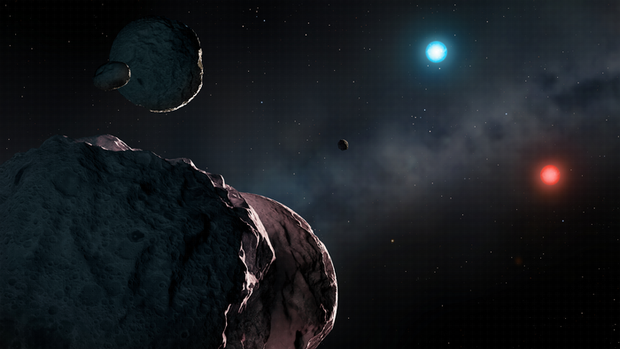WDJ2147-4035 is the oldest dead star with an evolved planetary system found to-date.
A white dwarf is a star that has burnt up all of its fuel and shed its outer layers and is now undergoing a process of shrinking and cooling. During this process, any orbiting planets will be disrupted and in some cases destroyed, with their debris left to accrete onto the surface of the white dwarf.

Artistic creation of white dwarfs WDJ2147-4035 and WDJ1922+0233. WDJ2147-4035 is red and dim, while WDJ1922+0233 is blue. Credit: University of Warwick/Dr Mark Garlick
Credit: Credit: University of Warwick/Dr Mark Garlick
Some day that will be us. For this study the team of astronomers modeled two unusual white dwarfs that were detected by the space observatory GAIA of the European Space Agency. Both stars are polluted by planetary debris, with one of them being found to be unusually blue, while the other is the faintest and reddest found to date in the local galactic neighborhood - the team subjected both to further analysis.
Using spectroscopic and photometric data from GAIA, the Dark Energy Survey and the X-Shooter instrument at the European Southern Observatory to work out how long it has been cooling for, the astronomers found that the ‘red’ star WDJ2147-4035 is around 10.7 billion years old, of which 10.2 billion years has been spent cooling as a white dwarf.
Spectroscopy involves analyzing the light from the star at different wavelengths, which can detect when elements in the star’s atmosphere are absorbing light at different colours and helps determine what elements those are and how much is present. By analysing the spectrum from WDJ2147-4035, the team found the presence of the metals sodium, lithium, potassium and tentatively detected carbon accreting onto the star – making this the oldest metal-polluted white dwarf discovered so far.
The second ‘blue’ star WDJ1922+0233 is only slightly younger than WDJ2147-4035 and was polluted by planetary debris of a similar composition to the Earth’s continental crust. The science team concluded that the blue colour of WDJ1922+0233, despite its cool surface temperature, is caused by its unusual mixed helium-hydrogen atmosphere.
The debris found in the otherwise nearly pure-helium and high-gravity atmosphere of the red star WDJ2147-4035 are from an old planetary system that survived the evolution of the star into a white dwarf, leading the astronomers to conclude that this is the oldest planetary system around a white dwarf discovered in the Milky Way.





Comments